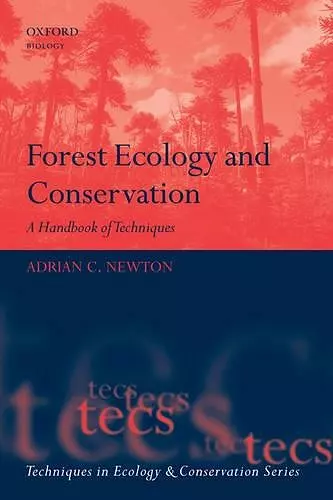Forest Ecology and Conservation
A Handbook of Techniques
Format:Paperback
Publisher:Oxford University Press
Published:17th May '07
Currently unavailable, and unfortunately no date known when it will be back

Forest conservation has become one of the most important environmental issues currently facing humanity, as a result of widespread deforestation and forest degradation. Pressures on remaining natural forests continue to intensify, leading to high rates of biodiversity loss. Understanding how human activities influence ecological processes within forests is essential for developing effective conservation action. This book describes research methods and techniques relevant to understanding forest ecology, with a particular focus on those that are relevant to practical conservation and sustainable forest management. This information is currently disparate and difficult to locate and, as with other books in this series, the intention is to provide a comprehensive synthesis for use by graduate students, researchers and practising conservationists. Methods are presented for assessing forest extent and condition, structure and composition, and forest dynamics at a variety of scales. Techniques for assessing genetic variation and reproductive ecology, and for evaluating the habitat value of forests are also described. Particular emphasis is given to state-of-the-art techniques such as remote sensing, GIS, computer modelling and molecular markers. However, traditional methods of forest mensuration and ecological survey are also presented. The methods and techniques described are generally applicable to all forest types, including both temperate and tropical forest ecosystems.
...an ideal reference for post baccalaureate students who are begining their research... * Bradley C. Bennett Quarterly Review of Biology *
'This is clearly and concisely written, and provides a thorough summary of key areas of forest ecology and critiques the various methods usedOverall, this is an ambitious and rigorous work that should be read by more than the intended readership.' Simon A. Queenborough, Environmental Conservation, Volume 34/4, 2008
In this thorough, well-written, and well-illustrated book, Newton intersperses relevant ecological theory and background information that together provide a rich context pertinent to the techniques illustrated. This book should be part of any forest ecology collection.
This book, and this series, will have an impact, not only in helping researchers improve their methods but also in conservation efforts on the ground around the world... Academics will be impressed by the scope and currency of Newton's treatment. Journal of Ecology 2008
Newton does very well in producing an excellent compromise in covering enough techniques to make the book useful without swamping the reader...This will be of use to ecologists at the sharp end of forest conservation but also to those looking for research methods appropriate for forests. Peter Thomas, Bulletin of the British Ecological Society 2007, 38:1
ISBN: 9780198567455
Dimensions: 234mm x 156mm x 23mm
Weight: 801g
472 pages